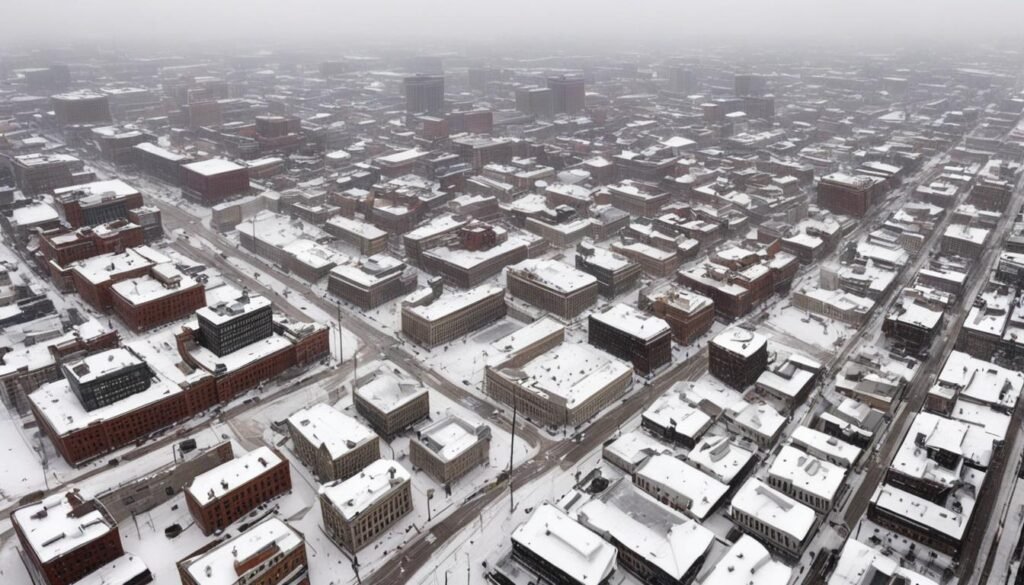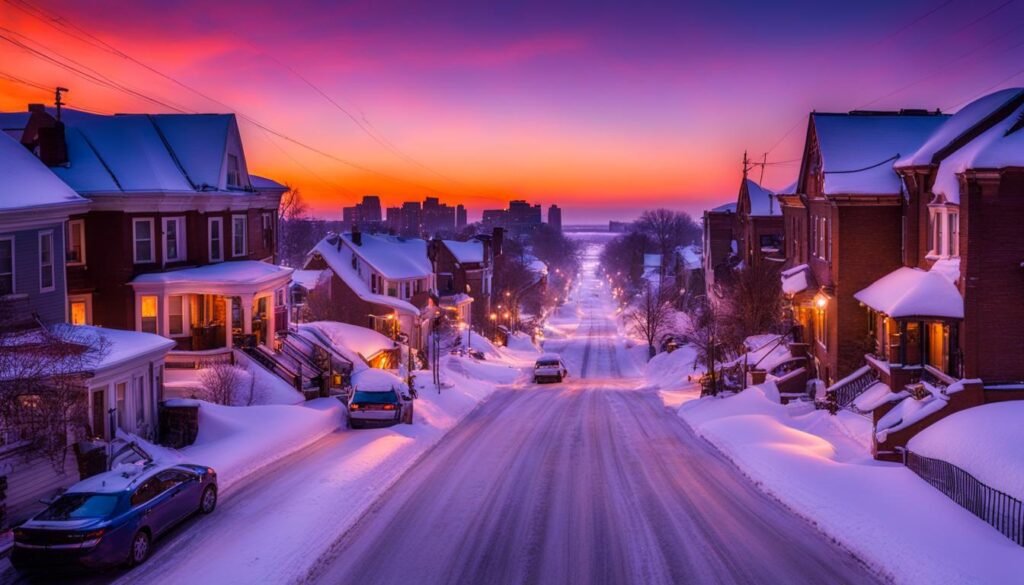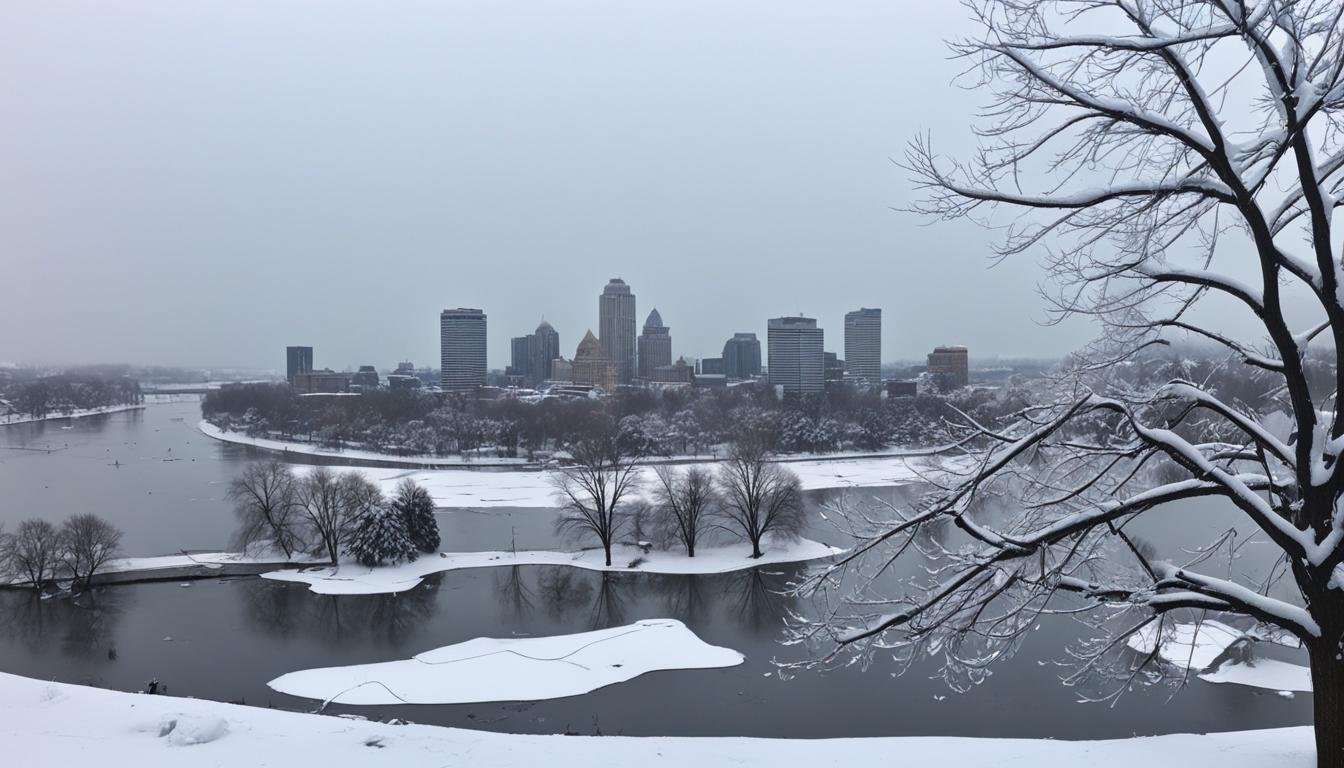Greetings! Today, I want to explore the question that many people ask: Does it snow in Buffalo? As someone who has experienced the winter wonderland of Buffalo firsthand, I can assure you that snowfall is indeed a significant part of the city’s climate.
Buffalo, NY experiences a fairly humid, continental-type climate with strong modification from the Great Lakes. Its winters are known for being cloudy, cold, and snowy, with frequent thaws and rain. But what sets Buffalo apart is the phenomenon of lake-effect snow, which contributes to a large portion of the city’s annual snowfall.
During the winter months, the direction of the wind determines the localized nature of the lake-effect snow in Buffalo. This means that some areas may receive heavy snowfall while others see less. However, it is worth noting that the city does not experience many heavy general snowfalls, as large-scale storm systems usually pass to the east.
Key Takeaways:
- Buffalo, NY experiences frequent snowfall during the winter months.
- Lake-effect snow plays a significant role in Buffalo’s snowfall.
- Large-scale snowstorms are relatively rare in Buffalo.
- Buffalo’s climate is influenced by its proximity to the Great Lakes.
- Winter weather in Buffalo is characterized by cold temperatures and frequent thaws.
Buffalo’s Snowstorm History
Buffalo, NY has a storied history when it comes to snowstorms. The city has gained its reputation as one of the snowiest cities in the US due to its frequent and heavy snowfall. Over the years, Buffalo has faced several notable snowstorms that left a lasting impact on the city and its residents.
Notable Snowstorms
- The Blizzards of ’77, ’81, and ’85: These historic winter storms brought record-breaking snowfall and caused widespread disruption in Buffalo. The Blizzard of ’77, in particular, is remembered for its intense snowfall, high winds, and subzero temperatures.
- Snowvember 2014: In November 2014, Buffalo experienced a massive snowstorm that dumped several feet of snow in just a few days. This event, known as Snowvember, resulted in significant snow accumulation and led to widespread power outages and transportation shutdowns.
Buffalo’s snowy reputation is further solidified by its multiple wins of the Golden Snowball Trophy, awarded to the city with the highest total seasonal snowfall among several cities in New York state.
Snowfall Records
Buffalo keeps records of snowfall and winter weather events through its weather archives. These records provide valuable insights into the city’s snowfall patterns and the impact of snowstorms. They serve as a valuable resource for meteorologists and researchers studying winter weather phenomena.
Now, let’s take a look at the snowfall trends and patterns that define Buffalo’s winter weather in the following sections.
Buffalo’s Winter Weather Patterns
One of the defining features of Buffalo winters is the frequent occurrence of lake-effect snow. Located near Lake Erie, Buffalo experiences significant snowfall due to the moisture-rich air interacting with the lake’s surface. This phenomenon results in localized heavy snowfall events that can greatly impact the city’s winter weather patterns.
The lake-effect snow season in Buffalo typically starts in mid-November and reaches its peak in December. As winter progresses, the intensity of lake-effect snowfall gradually decreases, especially after Lake Erie freezes in January. While lake-effect snow is the primary source of snowfall in Buffalo, the city also receives occasional general snowstorms, although they are less common.
The average snowfall in Buffalo is approximately 94.7 inches per year, with the actual amount varying from year to year. This significant snow accumulation contributes to the city’s reputation for snowy winters. Snow enthusiasts and local residents can expect winter wonderland scenes and opportunities for winter sports throughout the season.
| Month | Snowfall (inches) |
|---|---|
| November | 10.5 |
| December | 26.4 |
| January | 24.8 |
| February | 19.6 |
| March | 10.3 |
| April | 3.1 |
As shown in the table above, snowfall is most abundant in December and January, with November and February also experiencing significant snow accumulation. The snowfall gradually decreases as the winter progresses, and by April, the snowfall amount reduces to an average of 3.1 inches. These winter weather patterns showcase the unique snowy conditions that Buffalo residents and visitors can expect during the winter months.
Buffalo’s Snowfall Trends

When it comes to snowfall, Buffalo has a fascinating trend to explore. Data from the National Weather Service reveals that Buffalo’s average snowfall since 1965 has remained relatively consistent, with no significant directional trend. On average, the city receives about 94.7 inches of snow per year.
However, there is an interesting shift in the number of snowfall days. Since 1965, there has been a statistically significant decrease in the number of days with snowfall. This means that while the average snowfall remains consistent, more snow is now falling during fewer snowfall days.
To visualize this trend, here’s a table showcasing the average snowfall and the number of snowfall days in Buffalo for selected years:
| Year | Average Snowfall (inches) | Number of Snowfall Days |
|---|---|---|
| 1965 | 95.9 | 78 |
| 1975 | 89.6 | 72 |
| 1985 | 98.4 | 75 |
| 1995 | 88.3 | 69 |
| 2005 | 94.2 | 61 |
As the table demonstrates, despite fluctuations from year to year, the average snowfall in Buffalo has remained remarkably constant. However, the decrease in snowfall days suggests a shift in how snow is distributed throughout the winter season.
Buffalo’s Snow Cover and Lake-Effect Snow

Buffalo, NY experiences significant snow cover on the ground for a large portion of the winter season. During the core winter months of December to February, snow covers the ground in Buffalo approximately 63% of the time. Even during the extended winter period of November to March, there is still snow cover around 47% of the time. This highlights the enduring presence of snow and the wintry landscape that defines Buffalo winters.
The snow cover in Buffalo is influenced by the city’s proximity to Lake Erie, which contributes to the phenomenon of lake-effect snow. Lake-effect snow occurs when cold air passes over the relatively warm waters of a lake, causing the air to become saturated with moisture and producing localized heavy snowfall. Buffalo, being situated near Lake Erie, experiences frequent lake-effect snow events, leading to increased snowfall amounts in the region.
| Winter Months | Snow Cover Percentage |
|---|---|
| December to February (core winter months) | 63% |
| November to March (extended winter period) | 47% |
The combination of Buffalo’s favorable location near Lake Erie and the regular occurrence of lake-effect snow contributes to the city’s reputation for snowy winters. Snow enthusiasts can enjoy the picturesque scenery and outdoor activities that come with the abundant snowfall in Buffalo.
Conclusion
Buffalo, NY lives up to its snowy reputation with its frequent lake-effect snow and occasional general snowstorms. Despite a decrease in the number of snowfall days, the average snowfall in Buffalo has remained consistent since 1965. The city’s winter weather patterns, including snow cover and lake-effect snow, contribute to its status as a winter wonderland.
With an average snowfall of about 94.7 inches per year, Buffalo experiences a significant amount of snow. The region’s proximity to Lake Erie enhances the snowfall through lake-effect snow, resulting in localized heavy snowfall events. Snow enthusiasts can expect to enjoy the beauty of a snowy Buffalo winter.
Whether it’s taking part in outdoor winter sports or simply admiring the picturesque landscapes, Buffalo offers a perfect snowy setting. From the tranquil snow-covered streets to the glistening snowflakes falling from the sky, winter in Buffalo brings a special charm. If you’re looking for a true winter experience, Buffalo, NY has it all.
FAQ
Does it snow in Buffalo?
Yes, Buffalo, NY experiences snowy winters with frequent lake-effect snow and occasional general snowstorms.
What is the average snowfall in Buffalo?
The average snowfall in Buffalo is approximately 94.7 inches per year, with variability from year to year.
How does Buffalo’s snowfall compare to other cities?
Buffalo has a reputation for heavy snowfall and has been recognized as one of the snowiest cities in the US.
What are some notable snowstorms in Buffalo’s history?
Buffalo has experienced significant snowstorms, including the Blizzards of ’77, ’81, and ’85, as well as Snowvember in 2014.
Does Buffalo experience lake-effect snow?
Yes, Buffalo is located near Lake Erie, which contributes to frequent lake-effect snow in the region.
Are there records of snowfall and winter weather events in Buffalo?
Yes, Buffalo’s weather archives keep records of snowfall and winter weather events in the city.
Has there been a change in Buffalo’s snowfall over time?
The average snowfall in Buffalo has remained relatively consistent since 1965, with no significant directional trend. However, there has been a decrease in the number of snowfall days.
How long is the snow cover on the ground in Buffalo?
Buffalo usually has snow cover on the ground for about 63% of the core winter months (December to February) and about 47% of the extended winter period (November to March).
What contributes to Buffalo’s snowy winters?
Buffalo’s winter weather patterns, including lake-effect snow from Lake Erie, contribute to its reputation for snowy winters.

Leave a Reply